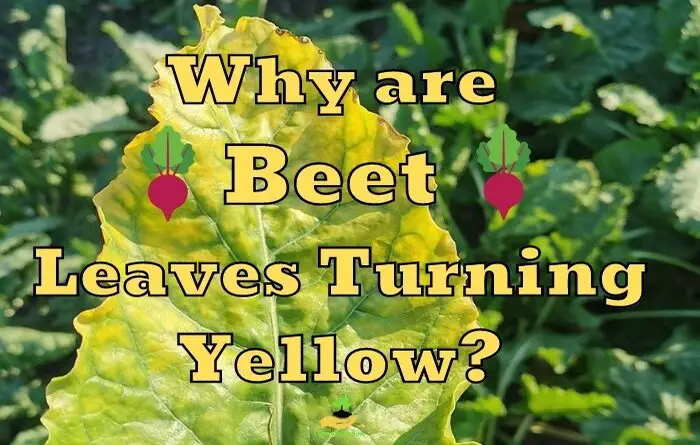Why are Beet Leaves Turning Yellow? (Quick Answer)
Beet is an easy to grow and care vegetable but often you notice that the leaves turn yellow. Let’s figure out together why beet leaves turning yellow and what to do about it.
| Reasons Beet Leaves are Turning Yellow |
|---|
| 1. Lack of water |
| 2. Nutrient deficiency |
| 3. Unfavorable soil structure |
| 4. Diseases |
| 5. Pests |
1. Lack of water
The first and most common reason why beet leaves are turning yellow is lack of water or lack of moisture. This is because a lack of water will prevent the nutrients from the roots to get to the leaves and as a consequence they will turn yellow and dry.
Even if basic nutrients are actually sufficiently available, there is no transport without a sufficient water supply causing beetroot leaves to not grow to their proper size, and later begin to fall off. The root crop in this situation becomes sluggish over time.
This issue can be caused by hot dry weather, irregular watering or poor rainfall. Beets are a water-loving vegetable, so regular watering, especially at the stage of root formation, is required.
In addition to the fact that high-quality and regular watering will prevent or eliminate the problem of yellow leaves, they will improve the yield: increase it by 2-3 times.
If there is no opportunity to water the beets often, then the soil in the garden needs to be mulched. This will keep moisture at the roots. Mowed grass, straw, peat are suitable as mulch.
On hot days, water more often. In rainy and cold weather, the frequency and volume of watering should be reduced. Beets should be watered under the root, avoiding water on the leaves and stems, so as not to provoke sunburn.
Yellow spots on beet leaves can indicate sunburn. They often appear after watering or fertilizing beets in sunny weather. Water droplets work in this case like magnifying glasses.
Treatment
So if the leaves on your plants are turning yellow, make sure you water them properly.
Because beetroot is a moisture loving plant it is important for the soil to be constantly moist. As a matter, if you have not watered the beets for a long time make sure to abundantly moisten the beet soil bed at least once a week.
The amount of water required for 1 square meter of beet bed soil is 10-15 liters per week.
The best time for watering is evening. The water should not be cold. It is advisable to let her settle first. To determine if the garden bed has been watered enough, stick your finger into the soil in several places.
If it rests on wet soil, then moisturizing is done correctly. If both the upper and the following soil layers are dry, watering should be increased.
2. Nutrient deficiency
Nutrients deficiency such as nitrogen, potassium and magnesium cause the yellowing of the beet leaves. Beetroot leaves react differently to a lack of certain nutrients as we see in the table below:
| Nutrient deficiency | Beet Symptoms |
|---|---|
| 1. Nitrogen | Leaves acquire a shredding and elongation look after which yellowing occurs. As time passed the entire leaf became yellow. |
| 2. Potassium | Leaf curl inwards and turn yellow due to chlorosis. Yellowing occurs between leaf veins. |
| 3. Magnesium | Outer beet leaves become chlorotic, as if burnt, yellow-red. The leaves become as if burnt, with pale yellow edges curled down. New leaves develop weak and uneven. |
| 4. Iron | Chlorosis on the beet lower leaves, their tips turning yellow and begin to die off. Often they can completely lose color, become pale, whitish. |
| 5. Manganese | Yellowing starts on the older beet leaves: small, irregular chlorotic spots, later covering the entire area between the leaf veins. |
It is nitrogen that is responsible for the formation of green mass in plants, and when it is lacking, the leaves do not grow well, first their veins turn yellow, and then all of them entirely.
In addition, the culture is sensitive to the insufficient content of boron and manganese in the soil . This problem is typical for sandy and calcareous soils.
Chlorosis is characterized by yellowing of the leaves due to the weak formation or destruction of chlorophyll. The causes of the disease can be: lack of nitrogen, manganese, magnesium, iron, poor soil aeration, viral diseases, as well as damage and disease of the roots.
Thus, yellow beet leaves are a signal of poor nutrition. What to do? Appropriate fertilizing and watering is required.
Treatment
If you see that the beet leaves are starting to turn yellow, you can fertilize extra with, for example, cow manure pellets. In this way, extra nitrogen is added to the soil, so that the leaves can become green and healthy again.
In order to prevent yellow leaves on beets you need to fertilize it 2-3 times per season as follows:
If you notice that the beet leaves begin to shrink, and then turn yellow, then most likely the problem is nitrogen starvation. It is necessary to apply nitrogen-containing fertilizers.
Beetroot needs the following amount of plant nutrients per 10 m²: 140–165 g N, 30–40 g P, 150–200 g K, 20 g S and 30 g Mg.
When leaves form liquid fertilizer must be used : chicken manure (1:12). After this stage organic fertilizer like wood ash must be used.
Fertilize when leaves appear on the beetroot plant and it really starts to grow. You can fertilize with 1-2 cm of well-turned compost once a month from May to September.
The use of chemical fertilizers should be avoided, as they feed on root crops that are eaten. It is also unacceptable to use fresh manure.
Spread the compost between the beet roots. You can also choose to buy ready-mixed fertilizer either in liquid or pill form. You can buy pre-mixed organic, organic and mineral fertilizer types .
3. Unfavorable soil structure
The most important physical factor causing yellowing in beet leaves is unfavorable soil structure and the resulting lack of oxygen.
When there is a lack of oxygen, the absorption of nutrients is reduced. As a follow-up reaction, the beets show clear symptoms of nutrient deficiency as leaf yellowing, similar to a lack of nitrogen, manganese and magnesium, although the soil is sufficiently supplied with nutrients.
The roots, or part of them, may turn black. This limits the absorption of nutrients. The pale foliage color looks a lot like a nitrogen deficiency.
On plots where a lot of rain fell this summer, the soil will be waterlogged. This issue will create oxygen deficiency.
Not a lack of nitrogen, but a lack of oxygen with its great influence on the root and soil life as well as the metabolic processes in the beet plant are responsible for the yellowing of the leaves and the disturbed beet growth.
In addition, susceptibility to disease is increased.
Treatment
It is important to prevent problems with targeted measures such as timely and professional soil cultivation, improvement of mulching and soil aeration.
Mulch sowing should be aimed at stabilizing the soil structure and maintaining a good soil structure.
Beetroot can be grown in all garden soil, but light sandy soil and stiff clay soil are less suitable. The soil must be well worked, but the soil does not need to be loosened as deeply as for e.g. carrots.
The root obviously finds an excellent way down, because the root depth of beetroot is 150–200 cm.
Mulch sowing does not show these problems: Oxygen exchange and thus the supply of nutrients is ok. Active soil life stabilizes the soil structure and maintains a functioning drainage system in the subsoil.
4. Diseases
Beetroots are attacked by a few pests and diseases and each disease has different symptoms as we will see below which will help you understand exactly what type of disease we are facing.
Beet leaves turn yellow when one of the following diseases occurs:
Beet yellows virus
It is caused by viruses transmitted by green aphids, which can be spread by black aphids.
The symptoms of beetroot mosaic virus are characterized by a yellow coloring of the beet leaves and more particularly, between the veins. Leaves turn yellow only when fully developed.
The veins sink into the underside of the leaves. Finally, reddish coloring due to the appearance of brown-red spots. It is for this reason that the leaves at the heart of the beet are always green.
Since viral yellows cause disruption of sugar transport through the vascular system, sugar accumulates in the leaves and the leaves become brittle.
Treatment
Beet yellows virus can only be prevented by adopting the following measures:
- Defend plants from aphids, which are the main vectors of viruses;
- Uprooting infected plants and eliminating them without putting them in the compost;
- Disinfect the knives with which we cut the diseased plants before using them for the healthy ones.
These plants should be destroyed before flowering to prevent seed production. An infected beet will produce thousands of seeds capable of germinating for ten to fifteen years.
The destruction of these beets will be done by means of the skimmer. A regular visit to the fields is recommended in order to eliminate these mounted beets and “weeds” as soon as they enter the reproductive phase.
Downy mildew
This disease is more common in young beet plants. At an early stage of infection, yellowing and curling of the leaves occurs, then covering with a gray-white coating.
The first symptoms of this disease are the appearance of spots on the underside of beet leaves
The causing fungus ( Peronospora farinosa ) is transmitted through the soil, seeds or plant debris. Favorable conditions for its reproduction are cool weather against a background of high humidity.
The source of the disease is often infected seeds, as in the previous case, so planting material must be disinfected with hot water, hardened in cold water and dried thoroughly.
Also, infection of beets can occur through the remains of diseased plants in the soil, therefore, after removing the affected bushes from the garden, it is also necessary to disinfect the ground.
Treatment
Is more likely to affect spring and autumn crops because the ideal temperature for the fungus is 10 ° C and it slows down significantly when it exceeds 20 °C.
In professional organic crops, plants can be treated with cupric products, scrupulously respecting the doses and methods of use indicated on the packaging.
Copper-based products, with the same precautions of use, are valid for all the other fungal diseases indicated below, and in very humid years they are also recommended in amateur gardens.
Verticillium wilt
Beet verticillium wilt is a disease of a wide range of plants caused by a fungus of the genus Verticillium. In addition to beets, it can parasitize turnips and many other crops. The peak of harmfulness occurs in the second half of summer, when the weather is hot and dry.
The leaves of beets during flowering are covered with yellow spots resembling a marble pattern. Affected leaf tissue first loses turgor, becomes light green, and then yellow.
Irregularly shaped spots on the leaf, large, vague, with chlorotic edging. The leaves on the whole plant droop and dry from the bottom up.
An outbreak of infection is facilitated by high humidity, sharp fluctuations in temperature and poor ventilation of the soil.
This beet disease overwinters on soil and plant debris, its spores retain their vitality for many years, which is why it is so difficult to avoid damage to crops.
Treatment
Well-known preventive measures will help to reduce the pathogenicity of the field – the use of crop rotation, the destruction of plant residues, and the sufficient content of phosphorus and potash fertilizers.
The field must be sown with high-quality seeds, which are treated with an antifungal disinfectant. During the growing season, preventive treatments are carried out with the fungicidal drugs.
5. Pests
The last reason why beet leaves turn yellow is pests infestation:
Beet Aphids
Aphids are one of the most common pests in the entire world, causing damage by stinging leaves. Adult insects and larvae suck the juices on the underside of the beet leaves, causing the entire leaf blade to deform and curl.
Damaged leaves turn yellow, curl, their edges and tops turn down, lose their elasticity, wither and dry out in dry weather. Beet growth is delayed and the weight of root crops is sharply reduced.
The parasite is dangerous because it sucks the juices out of the plant and transmits the beet yellows virus.
Treatment
Keep in mind that you can use natural, chemical and even biological remedies, with the incorporation of some predator of the aphid.
Natural enemies of beet aphids: beetles and ladybug larvae, larvae of hover flies, common lacewing.
These beneficial insects must be attracted to vegetable gardens by sowing various nectar-bearing plants (onion, carrot, cabbage and other crops), on the flowers of which they often concentrate, and then move to beets and other plants where aphids are present.
If the infestation pressure is high during dry weather, targeted spraying with an insecticide approved for this purpose.
Beet Flea
Jumping beetles ( Chaetocnema tibialis or Chaetocnema concinna ) oval or elliptical in shape, less than 2.5mm in size, blue to dark metallic brown that feeds on beet leaves.
You can find out that a flea has settled on a vegetable crop by the yellowed tips of the leaves and small holes on the leaf plate. The parasite begins active harmful activity in July.
Symptoms visible from seedling to ground cover, mainly in spring and occasionally in summer.
Treatment
It is difficult to deal with it, it is easier to prevent its occurrence. To do this, use preventive spraying with infusions of onions, garlic, potatoes, celandine, and also regularly weed weeds.
How to Prevent Beet Leaves from Turning Yellow
To prevent beet leaves from turning yellow is necessary to take preventive measures:
- Keep beet rows clean: weed at least 2-3 times during cultivation and at the end of autumn.
- Apply a fertilizer boost periodically with all the necessary nutrients.
- Water when the seeds emerge, then during the root enlargement phase, if the weather is dry. Make sure to use warm water.
- Loosen the soil before planting.
- like most root crops, it does not adapt well to clay soils , and it needs a soil that is well supplied with nutrients , especially potassium.
- To enrich it, ash and earthworm humus can be added.
- Perform crop rotation and for at least 2 years don’t plant beetroots in the same place.
- Carry out preventive spraying against diseases and parasitic insects.
- Choose beet varieties that are resistant to pests and disease.
Conclusion
Now you know why beet leaves turn yellow and how to deal with it. Take care of your vegetable properly, and you will enjoy it’s harvest in the autumn.
No, beetroot cannot withstand frost, so you should ideally harvest them before the night frost comes – this is typically at the beginning of October.




